Text
In AHistory (or at least the third edition of it), Lance Parkin asserts that there was a deleted line in his Tenth Doctor novel The Eyeless that would confirm the Eighth Doctor was betrayed by his then-companions at either his death and regeneration, the destruction of Gallifrey, or both. He specifically reveals this as a mirror to the scene in the rather forgotten (heh) comic The Forgotten, where the Tenth Doctor tells Martha that the Eighth Doctor was born alone and died alone.
Ignoring the fact that I’m very goddamn upset that this was not in the published novel, it’s actually incredibly interesting for the continued implications it gives to Lance Parkin’s bizarre-but-wonderful take on the pre-The Day of the Doctor NuWho Time War.
(First off, I must say, had this line been in the finished book, if you squinted, it would have very easily lined up with the Night of the Doctor. Cass takes on a very brief companion role, “betrays” the Doctor’s offered hand of help and travel, and it all leads to his death and ultimate regeneration on Karn with the Sisterhood. But, obviously, The Eyeless, and this line, were written before Night of the Doctor, and before Moffat (for better or for worse) closed off any future Time War narratives, simultaneously withering all prior narratives birthed in the Wilderness years or fandom imagination. That’s not meant to be hateful or anti-Moffat btw, just factual. It was going to happen eventually.)
Parkin’s original intent with his hint of the Eighth Doctor’s final moments, betrayed by his companions, was born in 2009, before The End of Time had aired, when the Time War was still mostly mystery. One of my favorite parts of AHistory is when Parkin presents a fascinating Time-War theory that combines the RTD era NuWho lore and The Gallifrey Chronicles’ retconned version of The Ancestor Cell:
But could Gallifrey have been destroyed just once? The Doctor certainly experiences the destruction of Gallifrey twice, in two different contexts. But this doesn’t rule out it being the same event. If there was only one destruction of Gallifrey, he and his future self would have to be present, and both culpable.
Surprisingly, this already fits what we know from The Ancestor Cell - the Doctor’s future self, Grandfather Paradox was there. Moreover, this future eighth Doctor fits everything we know about the Doctor who fought the Time War: fighting a vast time war has scarred him, made him lose his faith in humanity, made him a little callous. In The Gallifrey Chronicles recap of the end of The Ancestor Cell, Grandfather Paradox even wears a leather coat. As for the destruction of Gallifrey - The Doctor’s description in Dalek, “I watched it happen … I made it happen… I tried to stop it” is a neat summary of his actions in The Ancestor Cell.
If this theory is true, the Doctor’s memories of the War are conflicted because he was literally fighting his (earlier) self over “pulling the lever” that destroyed Gallifrey. So it’s Grandfather Paradox who has fought the Last Great Time War, the Daleks, the Nestenes, and so on. He goes back to The Ancestor Cell having done all that, confronts his earlier self… Who then outsmarts him by blowing up Gallifrey. Following this defeat, it’s Grandfather Paradox who regenerates into Eccleston (growing his arm back in the process).
For this to be the case, it involves the introduction of the tiniest bit of extra information: the War that’s being fought in the future has the Daleks in it and at some point they make a decisive move on Gallifrey. What the “current” eighth Doctor doesn’t know - but which his future self does - is that, in the future, the War’s going so badly that the Daleks are heading for Gallifrey. The Daleks were ruled out as “the Enemy” in Alien Bodies, but they don’t need to be for this theory to work - they just need to be capable of hitting the Time Lords hard.
Now, most of Lance Parkin’s theory is based almost entirely on Lance Parkin’s recontexualization of The Ancestor Cell, found in the, very Lance Parkin-ish, Lance Parkin’ novel The Gallifrey Chronicles. In the original The Ancestor Cell, Grandfather Paradox is revealed to be a future Eighth Doctor contaminated by the Paradox virus, who, at an unclear point in the war, travels back to right at its beginning and leads the true (but incredibly badly written) Faction in an invasion of Gallifrey to conquer it, rewrite its history, reclaim it in the name of paradox, etc etc.
In the recontextualization of TAC in the The Gallifrey Chronicles, however, with additions from Lawrence Miles’ own retconning in interviews and The Book of the War, an aspect of the Grandfather who just so happens to be the future Eighth Doctor, from specifically 292 years into the War, decided the War was going so badly, takes control of a rouge and parodic separate sect of the Faction, travels back in time and leads an invasion of War Queen Romana III’s Gallifrey at the War’s beginning specifically to take control of the War and change it’s outcome.
(Regarding the “292 years,” for more context, The Book of the War and most Faction novels other than Head of State and Spinning Jenny takes place only within the first 50 years of the War. Alien Bodies was originally intended to take place 500 years into the War (so, therefore, similarly casts Interference and The Taking of Planet 5 with the same dating assumption), but it remains a discussion point in the FP fandom whether or not that still holds with the BBV and Magic Bullet audios.)
So, in the end, Lance Parkin’s view of the Time War as of 2011, in the TLDR version, is this: one version of the future Eighth Doctor experiences the first two centuries of the War, sees that the Time Lords are losing to the enemy, the Daleks enter the fray as an extremely powerful force and make things worse for the Time Lords, and while being rotted and twisted by the Paradox virus, takes control of a (REALLY BAD) splinter sect of the Faction, leads an invasion of Gallifrey at the War’s beginning, encounters his old self, blah blah blah, Gallifrey blows up, the “current” Eighth Doctor goes into The Burning while the Grandfather Paradox Doctor regenerates into Eccleston, clears his mind, and goes into NuWho.
And you know what’s funny about this? The Daleks are not actually blatantly confirmed to be the main Enemy of the Time War until Gridlock, and while certainly it was the implication, you could totally force a “the Daleks weren’t the only enemy” agenda while watching series 1-2 (also nobody seems to remember that the Ninth Doctor implies the Time War is still happening in Rose).
So, why bring all this back to The Eyeless? Parkin, all throughout his Tenth Doctor adventure, constantly implies and hints that the Weapon creating the story’s conflict is the weapon that destroyed Gallifrey, or at the very least is related to the Time War. The Eyeless also has a haunting sequence when the Tenth Doctor remembers Gallifrey’s destruction in the Time War… and it’s word-for-word the destruction recounted in The Gallifrey Chronicles with the Eighth Doctor. Even if his AHistory theory doesn’t and can’t line up with The Eyeless’ idea of the Weapon, Parkin irrefutably asserts in The Eyeless that the destruction of Gallifrey in NuWho’s Time War and the destruction the BBC Books’ Eighth Doctor experienced are one and the same.
Which leads us to “being betrayed by his companions.” Because the only person who could remotely fill that void in The Ancestor Cell/TAC: The Gallifrey Chronicles Cut is Father Kreiner, who is pulled into the Grandfather Doctordox’s fight, and who ultimately “betrays” him for the “current” Eighth Doctor, leading to the destruction of Romana’s Gallifrey and the defeat of the (shitty) Faction Paradox.
Which only makes sense, as does all of Parkin’s theory, if you really remember and stress that the Grandfather Eighth Doctor is fucking insane.
From the POV of the real Eighth Doctor, the “hero” of The Ancestor Cell and The Gallifrey Chronicles, the future reflection twisted into the Grandfather is evil, ugly, nasty, war-like. But, also, mentally unstable. So think of this whole affair, this whole theory, from that Doctor’s POV. He sees the Time Lords losing the War, he sees his oldest enemies entering the fray, the War is ending with the utter destruction of everything, so he dons the guise of the Grandfather, leads a bunch of rebel teenagers pretending to be the Faction to the Gallifrey he knows best, recruits an old friend (Father Kreiner), only to be betrayed, fought against by his old self, who destroys Gallifrey, sending him to his rightful time, alone, lost, and regenerating into a Ninth Doctor with a clearer head, healed body, and confused and conflicting memories of what the living hell happened.
So basically, yes, I’m turning all this, all of this writing and reading, into more reasons to be said about Fitz/Father Kreiner.
None of this remotely matters anymore, of course. The Day of the Doctor did it’s thing, it was a mostly good thing, NuWho benefits from not being this complicated or connected, etc etc.
It’s still rather fun, innit? Or hurtful. Take what you will.
120 notes
·
View notes
Text
Notably, the term "Violent Unknown Event" originated in Peter Greenaway's 1980 film The Falls, which (like The Book of the War) is composed of short chapters in alphabetical order – and the number of chapters is 92, the atomic number of uranium…
The Book of the War’s entry for the enemy includes this ending:
To fully understand the nature of the enemy, it’s vital to understand the context in which it exists. See also the Churchill Index; Immaculata Formosii; the Gods of the Ainu; Miss Hiroshima; Mohandassa; Sixth Wave Defections; S’tanim; and Violent Unknown Events.
In one of the best-known and most-appreciated gags in The Book, none of these other entries actually exist. I’ve always assumed that the enemy just snuck in and edited them out, but by carefully reading up on where the topics are mentioned elsewhere in The Book, I think there’s a much subtler explanation, and I think it points somewhere pretty interesting.
Keep reading
99 notes
·
View notes
Text
A friend complained to me about the Doctor’s role in Class. Twelve just dumps Charlie and Quill at Coal Hill and disappears without warning anyone, basically leaving a whole school of kids in the line of fire of invading aliens. As a result, the Doctor is morally culpable for everyone who dies in the show. My friend blamed this on “lazy, sloppy writing” and said, “I have a real problem with them making the Doctor a completely amoral ass just because they were too lazy to come up with a better premise.”
I completely agree that the Doctor is responsible for anyone who dies at Coal Hill as a result of Charlie and Quill being there. But this isn’t the authors’ fault: it’s totally in-line with the Doctor’s characterization! It’s explicitly called out in Human Nature, when the Family of Blood kills a ton of people because the Doctor hid there for no reason. And this is also applicable to a ton of other stories, as well: despite being the universe’s top of morality, the Doctor only practices what he preaches when it serves his own purposes. Which it often does! But when it doesn’t, we see what he’s really made of.
For instance, contrast 10′s “no second chances” in The Christmas Invasion with him being “the man who wouldn't” in The Doctor’s Daughter. By ruining Harriet Jones’ administration over her killing one ship of Sycorax, he ruined Britain’s shot at a golden age, paved the way for the weak extraterrestrial policy of the Children of Earth administration, and created the power vacuum for Harold Saxon to fill.
And speaking of Harold Saxon! Martha spends a whole year traveling the world in miserable conditions, her family tortured and enslaved, all for the Doctor … and then when her desperate plan finally comes to fruition, what does the Doctor do? He weeps into the body of the man who unrepentantly killed all this genocide and destruction, begging him to not die, begging him to come travel with him. No wonder Martha left! The fact that Missy and the Doctor are still friends, and that he sees their fighting as a game, should speak magnitudes about what the Doctor really thinks of us.
And this isn’t just a Tenth Doctor thing. 11 does a ton of similar stuff (cough cough Girl Who Waited), and in 12′s very first episode he (deniably) murders the clockwork dude, in cold blood. There’s a reason the Doctor turns everyone he meets into an adrenaline junkie, a soldier, or a corpse …
299 notes
·
View notes
Text
“Legends of Earth”: The 2020s “Doctor Who” Anthology Which Never Was
Something very special today. Usually, when it comes to the production history of more or less Doctor Who-related fiction, I natter about the obscure and deuterocanonical — but did you know that around Summer 2020, Emil Fortune was working on creating an anthology of Doctor Who short stories riffing on “Myths & Legends” of Earth, whose title eventually settled as Doctor Who: Legends of Earth?
Due to the poor sales with which DWU books increasingly became saddled during the Chibnall era, it was ultimately canned. Had it happened, it would have constituted a rare case of an official Doctor Who book in the ear of NuWho opening up pitching calls to first-time writers, with the point of the book having been to reach out to beginning writers from outside the UK, to write about elements of their native cultures in particular.
As another reliable source explained: “It sounded really really cool, and [Emil] was trying so hard to do it right. Reaching out to all the right people. Getting totally new voices in. It would've been amazing.”
Perhaps more pitches will become known in time; for the time being, I have only been able to track down one of the prospective writers, S. Brennan, who submitted two pitches related to Irish folklore — archived here after the cut with permission.
(I was actually meant to do this months and months ago — my heartfelt apologies to S. for letting it slip through the cracks.)
Coat of Charms
S. Brennan's first suggestion was a Sixth Doctor story riffing on St. Bridget of Kildare.

The pitch was developed further after this initial offer, with it being confirmed to Brennan that an extended-universe companion such as Evelyn unfortunately could not be used for this project, and would have to be replaced with a TV companion.
With Coat of Charms eventually proving difficult to develop into something which fit the intended tone of the book, they pushed onwards with another pitch, this one featuring an even more prominent figure from Irish folklore.
The Way of Battle
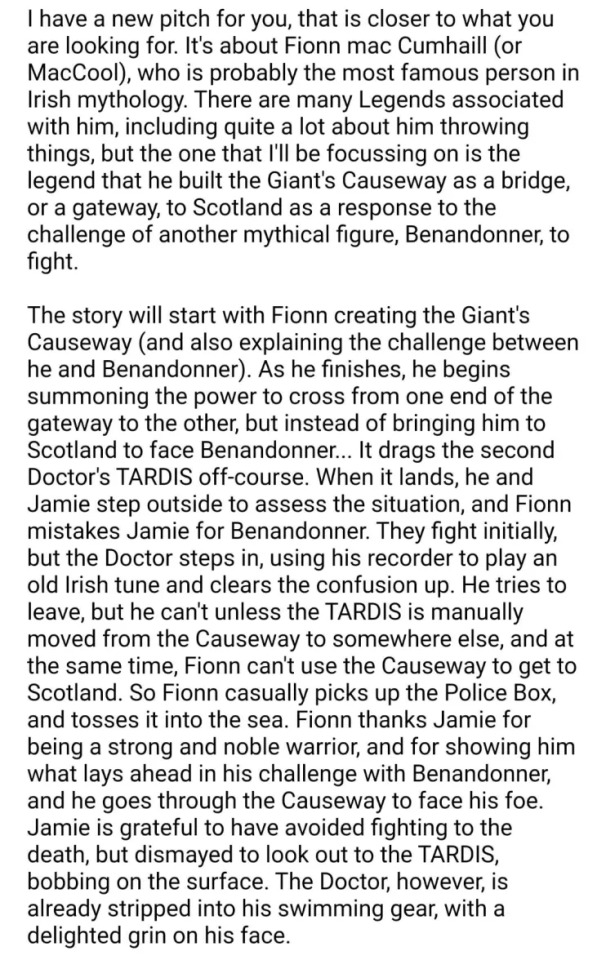
Per S. Brennan's connection, however, this pitch was never discussed further, with them assuming that the book had already been “canned” by then.
A sad end to what would have been one of the most interesting offerings of the BBC-licensed EU of the 2020s. The only silver lining is that no exclusivity contracts or NDAs had been signed with prospective writers — meaning that those lost stories can be discussed, and perhaps brought into being through some other medium, whether it be something like BF's Lost Stories range (it would certainly beat scraping through Terry Nation's drawers for first drafts) or beyond the aegis of the BBC altogether.
At any rate, if anyone reading this post has more information on Legends of Earth and related stories-that-might-have-been, please get in touch!
42 notes
·
View notes
Text
this is probably an unpopular opinion but I think interpreting the doctor as passively evil is an interesting character experiment. like, by human standards they’re pretty much an immortal, ancient, godlike entity. they travel all of time and space, saving or destroying entire civilizations on a whim. they travel with humans because they’re obsessed, almost addicted, to human mortality and naivety. sure, they claim to love their companions, but involvement in their lives almost always ends in misery, and then it’s onto the next. imagine the TARDIS filled with abandoned bedrooms, clothes on the floor, beds unmade, toothpaste in the sink. their things frozen in time, dust-covered and tomblike. and the doctor is drifting through space, surrounded by evidence of all the lives they’ve ruined. anyway, if anyone has evil doctor fic recommendations pls drop them below.
767 notes
·
View notes
Text
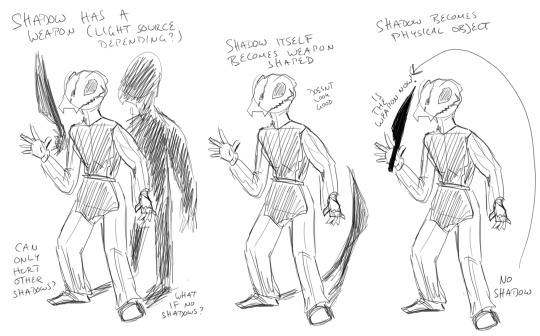
Thinking about Faction Paradox shadows
I still like the idea in Unnatural History? Faction Paradox members not having shadows because they are no longer "real" in Causality
But then would the sombras que corta itself work as a fake replacement shadow? Or do you need a shadow to pick one up?

37 notes
·
View notes
Text
Who is the Prisoner from Dellah? or How I Learned to Stop Worrying and Love the Benny Clone
In Dead Romance, what is considered by many to be the best novel written by Lawrence Miles, a young woman by the name of Summerfield who discovers a series of existentially terrifying things about her life –not only is the world that she resides within a pale imitation held within a bottle, but she herself is a pale imitation of someone else. Not only is she a clone made from a “generic human template”, but her memories are of some young blonde woman from within the bottle. Also it’s the end of the world.
So, not a great day to be Christine.

Now Christine Summerfield has some special significance for fans of the Doctor Who Wilderness Years, as she eventually escapes her bottle universe, chooses a name all her own, and makes some very interesting friends. But there's not much we know about that generic human template she was crafted from. So little, in fact, that some were led to believe that she was a clone of Chris Cwej himself (but we won't get into that).

Mr. Christopher 'Rodan's Wedding' Cwej needed to sacrifice three people, three people with minds and hearts and fingers and toes. But he couldn't do it. He couldn't kill real people. Not even real bottle people. So the Homeworld gave him cloning equipment. The same equipment they were using on the outside of the bottle on Simia KK98. And here is where Chris tells us about the sample they've been using for their sacrifices to the All-High Gods. The "Prisoner from Dellah".


So, know very little about this woman, but we certainly know slightly more than nothing from the brief conversation about her.
She is human.
She came from Dellah.
She, at the time she was captured, was a follower of the All-High Gods.
She was on "some kind of mission."
She knew is, at the time of the story, presumed dead.
She knew the "terrible truth" about the Enemy and the bottle universe.
So, let's look at what we know about Bernice Summerfield, at this present moment –starting with the immediately preceding story, The Mary-Sue Extrusion by Dave Stone.

For a start, Bernice Summerfield is a human. Relatively innocuous detail, but we’re working with so few that it bears mentioning.
At the time, Bernice Summerfield was working a job at St. Oscar’s University on Dellah, until St. Oscar’s was destroyed –with Bernice Summerfield presumed dead.
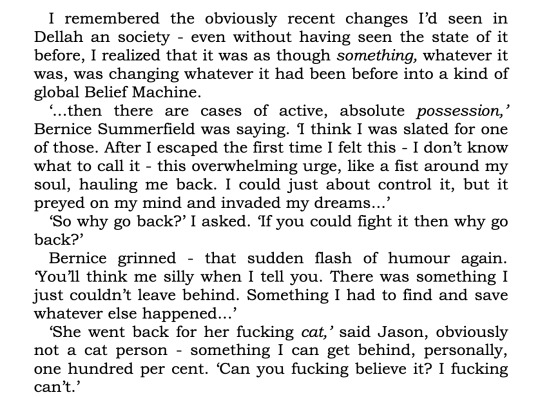
In reality, however, she escaped Dellah and had traveled to the Proximan Chain so as to avoid the overwhelming influence of the All-High Gods –an influence that “preyed on [her] mind and invaded [her] dreams…”.
But she had to return, because there was “something [she] just couldn’t leave behind. Something [she] had to find and save whatever else happened…” Her cat, Wolsey. This is, of course, because Bernice Summerfield has her priorities straight.
Now, Dead Romance takes these similarities head on –asking the question: “Was it really a coincidence that the person who got mixed up in Cwej’s life just happened to have the same surname as one of Cwej’s oldest (and apparently deadest) friends?”

Throughout Dead Romance, two things about Bernice Summerfield are true.
Bernice Summerfield is presumed dead. Moreover, Mr. Cwej is incredibly sullen whenever a possible similarity between Christine and Bernice is raised. Almost as if seeing the face of his dead friend whom he's going to have to kill is depressing or something?
Christine Summerfield feels a very strange connection to Bernice Summerfield.
All that’s really left in the air is whether Bernice Summerfield was aware of the “terrible truth"!
If only there was a story in Dead Romance where Chris talks about his time traveling with the Seventh Doctor and his other companions, ripping through Sphinx Space, and recovering the Bottle...

And if only the Seventh Doctor traveled with Chris Cwej and Bernice Summerfield at the same time at any point... (13 stories to be precise, but I can't put ALL the covers here)






As a sidenote! Apparently there was a universe-in-a-bottle tucked away in a small room near the TARDIS library for quite some time, since at least as early as Christmas on a Rational Planet.
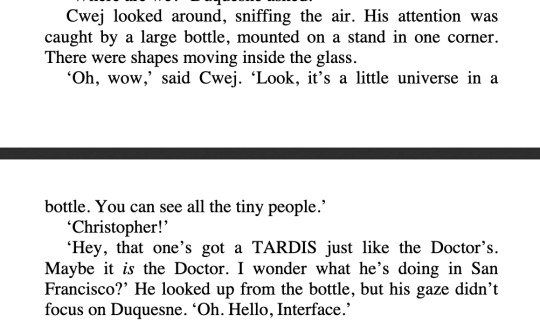
Apparently it contains the events of the TV Movie, but that can't be the Bottle recovered from Sphinx Space. Can it? The bottle that contain's Christine's World can be seen from both inside and outside. Perhaps we're seeing the Bottle Universe containing the Eighth Doctor Adventures from the other side? I digress...

Then, of course, there are the physical appearance things. I don't try and put a lot of stock into these, as physical descriptions in novels are often inconsistent or vague, but I think it's important to document it.

While she may have had the memories of a blonde girl, she herself had "dark hair", "dark eyes", "a wide open gawping mouth, [and] skinny cheeks that were much too narrow for [her] big head." Now I'm not going to say that's a perfect description of Bernice Summerfield (especially given she's meant to be a younger version of her) by any stretch, but I am going to gesture at Lisa Bowerman as Bernice Summerfield back when Dead Romance was released.
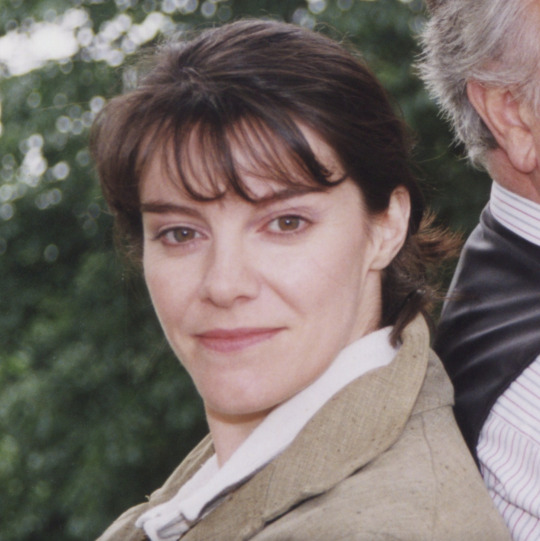

For added fuel to the fire, here is Lisa Bowerman at 20 years old.

TL;DR: Christine Summerfield is a human clone of the prisoner from Dellah, with memories imprinted on her from the blonde woman from the universe-in-a-bottle. The Prisoner from Dellah is Bernice Summerfield. Christine Summerfield is a clone of Bernice Summerfield.
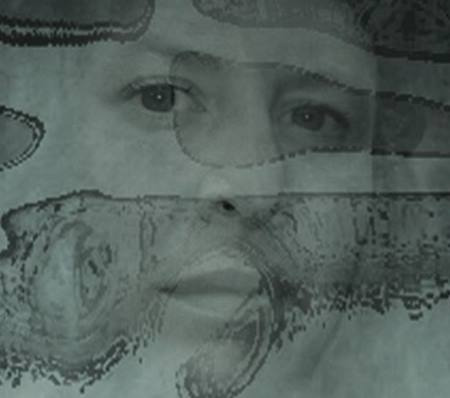

P.S. Don't ask me about The Five Christinas.
30 notes
·
View notes
Text
Random headcanon I came up with early this morning, because I’ve been thinking about Gallifreyan language recently:
The reason why so many Time Lord things are decorated with circular Gallifreyan, often too impractically to actually be read (eg. on the Moment), is because it’s a cultural touchstone that remains from pre-/early-Pythian Gallifrey’s use of magical runes and sigils.
Presumably it was more typically Old High Gallifreyan used in that time (though The Timeless Children does seemingly confirm circular Gallifreyan existed at least as far back as Rassilon's time, if not earlier), however. Twelve describes it as ‘the language of the Pythia’ in The Lost Magic, and as Eleven says in The Time of Angels:
ELEVEN: There were days, there were many days, these words could burn stars and raise up empires, and topple gods.
This is obviously very reminescent of the Carrionites' (themselves from the Dark Times too) "word-based science" from The Shakespeare Code:
MARTHA: What did you do?
TEN: I named her. The power of a name. That's old magic.
MARTHA: But there's no such thing as magic.
TEN: Well, it's just a different sort of science. You lot, you chose mathematics. Given the right string of numbers, the right equation, you can split the atom. Carrionites use words instead.
In other words, while they probably weren't actually intended as such and may have their own specific meaning, whether they be poetry, namesakes, histories, instructions, whatever... these are basically protective wards:
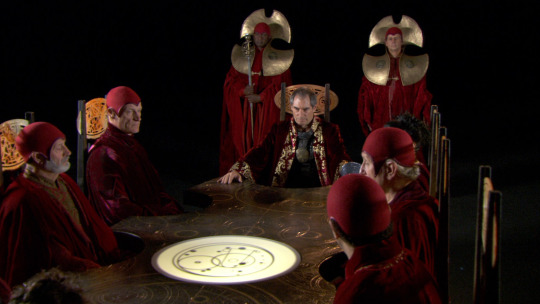




[ID: Five screenshots of Circular Gallifreyan in New Who.
1. Rassilon's Inner High Council meeting in The End of Time Part 2. The table and headrests are inscribed with circular Gallifreyan.
2. The Moment in Day of the Doctor. Gallifreyan writing bends round the edges of the wooden frame.
3. The 'whirligig' rotar in Eleven's second TARDIS, inscribed with individual Gallifreyan symbols.
4. Set photo of the glowing Gallifreyan writing on the steps of Thirteen's TARDIS.
5. Tecteun's laboratory in The Timeless Children. Circular Gallifreyan lines the light above her, and a door in the background.]
As a side note - if they actually are kind-of intended as a form of protection, perhaps this is why we were only introduced to Circular Gallifreyan in New Who, despite it seemingly existing through Gallifreyan history. Because it was retroactively inserted into Gallifreyan culture as a form of defense during the War in Heaven / Last Great Time War?
Regardless, this also opens up questions how many other Time Lord traditions are holdovers from the Dark Times.
For example, who's to say that the renegade naming tradition didn't begin as a form of protection from hexes - either from hostile forces in the pre-anchoring universe, or from oppressive magic-users back on the homeworld? This may also be connected to the change in Gallifreyan name format before and after the Intuitive Revelation (eg. ancestral -sti and -sor names), though shifting power structures, gender roles etc. presumably played a role too.
Heck, is this one reason why Gallifrey's own name has changed over its history? From Jewel to Gallifrey in Rassilon's time to try and protect it from vengeful Pythian curses. From Gallifrey to just 'the Homeworld' in the War to protect it from new rituals of alternative histories and paradox?
225 notes
·
View notes
Text
“Someone once said that if you’re a celebrity writing a “Day in the Life” feature for one of the magazines, then it’s vitally important for you to end the piece with your own personal catchphrase. Or the sentence you’re most famous for, anyway. So, in conclusion; no, it isn’t the bloody People.”
— Lawrence Miles on his daily routine (and the identity of the Enemy) [x]
32 notes
·
View notes
Text
youtube
At the end of my big TV Century 21 post, I joked that it meant The Beverly Hillbillies is part of the Doctor Who universe. Now I'm happy to say that some of that research made it into Quinton Reviews' discussion of "How the Beverly Hillbillies Changed TV"!
(You spotted that I was credited as a ghost writer, right? It's right around the 24 mark.)
(24 hours, that is.)
(And I thought The Tragedy of Yaz was long…!)
23 notes
·
View notes
Text
"what sort of freak makes a 38 hour video about the Beverly hillbillies?" I say, the sort of freak who is immediately watching the 38 hour video about the Beverly hillbillies
31 notes
·
View notes
Text
Some notes from the first episode of Dark Gallifrey:
Morbius was from an “unnamed House”
Morbius fought Rassilon’s successor, a President whose name is lost to time
Time Lords destroyed civilisations by dropping shards of their own future on them from orbit
Old Gallifreyans travelled through the Vortex in wooden ships manned by hundreds of people
These ships could twist and morph during travel, crushing crew below decks
Earth crows were once creatures of the Vortex. They settled on many different worlds during Morbius’ War
Time Lords could bestow regenerations on Outsider Gallifreyans as medals of honour. They said those regenerations could give one an extra heart…
73 notes
·
View notes
Text
youtube
in which Paul Magrs talks about a cancelled Doctor Who novel series that would be "cover versions" of Classic stories, and his pitch to adapt The Dæmons with 13 and Missy! 👀
I wish there'd be a proper sequel to The Dæmons. At some point, when Jodie Whitaker was the Doctor, there was talk of doing a series of books that were cover versions. In which the Doctor and her current companions would – because of the Time War, because of whatever reason we could come up with – they would redo a story. And how would that change in the present day. And I was longing to do The Dæmons.
The Dæmons would be set here on south Manchester, in a church in the inner city where the city had encroached and built over the graveyard where the church stood on the high street, and the church was now, I don't know, a community center or a greengrocer or something. And you'd still run the story of Miss Hawthorne and Missy, it would be, being the local vicar summoning up the Devil.
But it never happened. We never got to do this series of cover versions. I'd still love to it – I still think mine would be fantastic!
46 notes
·
View notes
Note
I was wrong! A friend has pointed me to a 2007 issue of DWM which laid out the facts quite clearly and seriously:
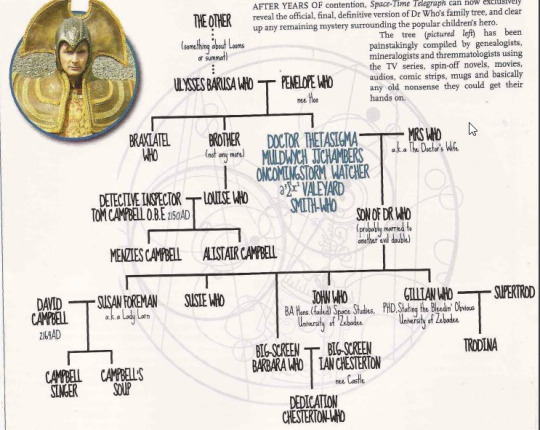
Is Ulysses, as tardis wiki claims, Irving Braxiatel's father?
No! Ulysses is clearly the Doctor's father, and Braxiatel is clearly heavily implied to be the Doctor's brother, but no story has connected the two. So while it's an understandable assumption for the wiki to make, it's also an unjustified one. After all, there remains the strong possibility that Ulysses is Braxiatel's mother!
98 notes
·
View notes
Text
The Killer Cats of Gin-Seng
In Survival, the last regular serial of Classic Doctor Who, the Doctor and Ace visit a planet of humanoid cats called “Cheetah People”. The Cheetah People are highly telepathic: they can mentally control and inhabit their pet cats, and they can even teleport between planets. Most notably, one of them is played by Lisa Barrowman, better known as Bernice Summerfield.
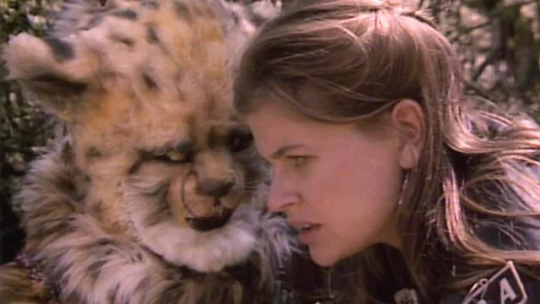
But this wasn’t actually the first time that humanoid cats had been set to appear in Doctor Who. In 1977, script editor Anthony Read commissioned his former collaborator David Weir to write the Season 15 finale, a four-part serial set on Gallifrey. The request was to explore society outside the Capitol with an emphasis on morality, a theme which Weir had written well in the past. So he pitched a story about Gallifreyan civilization of humanoid cats.
The Gallifreyan cat-people would have mirrored real-world cats’ dual penchant for both sophistication and savagery: they would appear advanced and civilized until the Doctor wound up in one of their elaborate gladiatorial displays! Weir delivered his scripts on time, and production proceeded to the point that Dee Robson designed costumes for the cat actors.

Ultimately the story was cancelled: Weir, by all accounts an excellent screenwriter, dramatically overestimated the show’s VFX capabilities and budget. But executive producer Graham Williams later mentioned the idea at a fan convention, so it became well-known in fandom (albeit under the false name The Killer Cats of Geng Singh). As a result, when Survival finally brought cat people to screens, fans naturally canonwelded the two.
One of these fans was Adrian Middleton, editor of the Apocrypha fanzine. Here’s how Apocrypha issue 1 covered the cats:
Apocrypha on the Killer Cats
THE GIANT CATS -16,000,000
The first intelligent mammalians on Gallifrey evolved from its version of the sabre-toothed Tiger. These giant cats developed a rudimentary form of empathic communication, which allowed them to influence the actions of their prey.
Over an extended period of time, the cats developed a finer telepathic ability, allowing them to actually control other species. This became a necessity as feline culture grew, as their physiological form prevented the use of tools to build or write with. Thus, in spite of their intelligence, the cats could not establish a true civilisation without anthropoid assistance.
FELINOID CIVILISATION -14,000,000
Early Gallifreyan hominids soon became the tools of feline culture. The first buildings on the planet were built by hominids but designed by cats, taking the form of vast stone arenas, in which the cats would use lesser species for sport - hunting and killing for pleasure rather than survival.
HOMINIDS -14,000,000/-13,980,000
Forced to live alongside saurian and feline predators, Gallifrey's first hominid tribes evolved as creatures of guile and stealth. Communities were established using primitive communications. These hominids were the cave-people, the tree-people, and the river-people.
THE FALL OF THE GIANT CATS -13,980,000
The hominid tribes had at first been easy prey for the cats, easily manipulated as a supply of muscle and food. Ultimately, however, the development of feline culture accelerated the development of hominid culture. Being made to use their hands and having the telepathic parts of their minds manipulated awakened a new sense of purpose within them. Seeing the cats as their slavers, they rebelled, exposing the cats to a coup so bloody that the species was all but wiped from the face of the planet.
THE LEGEND OF THE VANISHING CATS -13,800,000
It is rumoured that, after their defeat by the hominids, the giant cats fled to the mountains, where they hoped to restore their numbers (perhaps in an effort to restore their power over the hominids). Often hunting parties would venture into these mountains, bringing back the occasional cat. It seemed that the mental strength of the hominids had come to match their feline contemporaries.
Other psychic powers were attributed to the cats, including the power of teleportation. In Gallifrey's southern hemisphere, atop one of its highest mountains, there stands a crudely erected stone circle. Gallifreyan archaeologists determined that this was built by the cats themselves. Legend states that the giant cats emigrated by mass teleportation to another worlds. Few giant cats were seen from this time on, and those that did appear bore no telepathic powers. However, smaller domestic cats, or Kitlings, retained this ability.
WHY LINK THE KITLINGS FROM 'SURVIVAL' WITH THE KILLER CATS OF GALLIFREY?
The 'cat' theme is one that has been expanded on greatly in recent years. Colin Baker's cat motif and 'I am the cat that walks alone' slogan, followed by Eric Saward's novelisation of 'Slipback', set a pace followed by 'Survival' and the 'Cat's Cradle' trilogy.
Upon learning about 'The Killer Cats of Ginseng' by David Weir, everything seemed to fit into place. Cats can't exist everywhere in the universe, they have to come from somewhere - we have Earth cats, and Gallifrey has telepathic or empathic cats, just like the Kitlings.
Commentary
Since the 90s, a few stories have referenced the killer cats idea. Gary Russell’s VMA Invasion of the Cat-People mentions “mercenaries of Gin-Seng” alongside the Cheetah People in a list of felinoid species (hence the “canonical” spelling); there’s a similar offhand mention in Big Finish’s Erasure. But there’s only been one actual appearance of one of the cats: Daniel O’Mahony’s Faction Paradox short story “The Return of the King” (pdf).
“The Return of the King” is a prelude to the author’s 2008 novel Newtons Sleep. In that book there’s a glimpse of “the nocturnal delegations of the wild things, whose sharp bright teeth and claws gleamed in the dark of their robes.” The prelude elaborates,
[Time Lord Thessalia’s] oracle stays at the window, seething playfully below his hood. He has fiercely intelligent eyes, neither as sharp nor as bright as his scar. His mouth is a succulent white smile in a lightless face. His people have nothing but contempt for the rituals of the Great Houses. She’s little better than prey to him, a bloodless snack for his long teeth and hungry mind. He breathes, honeyed air purring out of the cavities of his body.
A killer cat kept as a Time Lord’s personal oracle … as @rassilon-imprimatur once noted, a funny recontextualization of The Mark of the Rani’s reference to the Lord President’s “pet cat”!
This was my first exposure to the killer cats, so I always took it for granted that they’d always had psychic or oracular abilities. But in fact, as best as I can tell, there was zero hint of this in the original serial. I tracked down every published description of the story, and they all amount to the same few repeated bits of information: Gallifrey, humanoid cats, and a gladiatorial arena. Richard Bignell ultimately told me, “No summary of Killers of the Dark exists. Even David Weir couldn’t recall anything about it when I spoke to him.”
So when “The Return of the King” features an oracular cat-man, it’s not just a reference to the unmade Classic serial. It’s a reference to fan interpretations like Middleton’s which canonweld that serial with the psychic Cheetah People.
And in some ways, it seems to be referencing Middleton’s version specifically! In “The Return of the King”, the above quoted memory is interrupted by commentary:
Your first oracle?
‘My last.’
You think? But his kind were vanishing from the world.
‘They were escaping the War. They could see it coming.’
Compare:
Legend states that the giant cats emigrated by mass teleportation to another worlds. Few giant cats were seen from this time on, and those that did appear bore no telepathic powers.
And so Middleton explains how the cats vanished in O’Mahony’s telling, and O’Mahony explains why they vanished.
Afterword
While we’re on the topic of why, why did O’Mahony choose to revive this specific idea in “The Return of the King”?
One of the places I checked for Killers of the Dark details was issue 336 of Doctor Who Magazine. Imagine how thrilled I was to find that the relevant “Accidental Tourist” piece, located one page after a Faction Paradox ad, was written by none other than O’Mahony himself!
Part of his reflection was particularly striking. He recaps the wild undefinedness of the Doctor’s backstory, a topic I’ve discussed before on this blog. But in his telling, the uncertainty extends past The War Games all the way to The Deadly Assassin.
After all, The War Games declared that “the Doctor’s people are the Time Lords”, but “who are the Time Lords?” was still left undefined. In the Time Lords’ many subsequent appearances, they were simply walking plot devices, and lore details were left to the wayside. Contradictions were rife. Who was Rassilon to Omega? Is their planet called “Gallifrey” or “Jewel”? Who or what on earth are the “First”, “Second”, and “Third Time Lord” who exiled the Doctor?
It was The Deadly Assassin which first dove into the details by featuring the Time Lords like they were any other of the show’s alien cultures. And for this, it was widely panned: “the fans had voted it the worst story of Season Fourteen and published reviews vociferously attacking its ‘betrayal’ of the Time Lords. The BBC practically disowned it, physically vandalising the master tape to placate Mary Whitehouse.” In other words, the stage was all set for a discarding of Holmes’ Time Lords.
O’Mahony writes in his conclusion,
The Deadly Assassin could have remained a one-off, its vision of the Doctor’s homeworld set at odds not just with the Gallifrey stories of the past but also those of the future. The Killer Cats of Geng Singh was the last chance to slip the leash. Williams loved the Time Lords but he had a raft of other ideas he could have put into play, not least the frustratingly deferred Guardians who were clearly intended as a new rung of the series cosmology above and beyond the Time Lords. The premise of Killer Cats was also to counterpoint the Time Lords with another Gallifreyan species – a race of humanoid cats that delighted in bloodthirsty gladiatorial contests alongside a highly refined culture. This wasn’t cribbing from The Deadly Assassin, this was building something new that would expand the newly-forged mythology of the series. In fact, with the cat-people on board and the Guardians waiting in the wings, the possibilities for Time Lord mythology were fluid. It might be possible to return to Gallifrey and find something new and exciting each time, different Gallifreys, with a mutable and ever-expanding history.
However, thanks to Killers of the Dark’s cancellation, Williams and Read were left with a slot to fill on short notice, and for The Invasion of Time they ultimately turned back to Holmes’ ideas. The Deadly Assassin wasn’t discarded or undermined, it was reentrenched.
This was the real moment that the Time Lords as we know them were crystallized: a real-world anchoring of the thread. This was when the whimsically-named planet “Gallifrey” definitively transformed into the rationalistic, stagnant, bureaucratic Homeworld that would feature in the Faction Paradox series.
Because in FP, by the time Grandfather Paradox enters the scene, the Great Houses are total strangers to whismy. It’s only through the course of the War that their understanding of the cosmos is broadened and stranger things begin to return to the Homeworld (with great vengeance).
By showing us a cat in the flesh, O’Mahony is finishing the housekeeping: just as the Intuitive Revelation banished the Pythia, the Eremites, and the Carnival Queen; just as the Grey Eminence unwrote Gallifrey’s first childbirth; and just as the Eternals “despaired of this reality, and fled their hallowed halls” at first hint of conflict – the Killer Cats have to leave to set the scene for the War to come.
P.S.
In Baker’s End, Tom Baker wound up “the King of Cats”. What does this imply about the Other?!?
#Doctor Who Apocrypha#the return of the king#daniel o'mahony#archival#effortpost#newtons sleep#60s who#for archival purposes#only#no copyright infringement intended#will remove upon request#baker's end#the deadly assassin#killer cats of gin-seng#the invasion of time#fourth doctor#survival#faction paradox
41 notes
·
View notes
Text

Ok, so what's the over/under on this being a tie in to Wild Blue Yonder?
It's funny, cos I wonder where the Tardis goes at random. Maybe it lands on some outcrop by the sea. And there's a tribe and they worship it for 100 years. Then they grow up and try to burn it. Then they get wise. They preserve it. Then they build a city all around it, till the Tardis is just a tiny little dot, surrounded by skyscrapers and monorails. Time passes and the city falls. It all gets swept away. And there's the Tardis… still on its outcrop… by the sea. She's the only thing I've got left.
Maybe a sequel episode where this indeed happened, and Fifteen and Ruby return to find a civilisation built from a history of worshipping the TARDIS?
102 notes
·
View notes
Note
Is Ulysses, as tardis wiki claims, Irving Braxiatel's father?
No! Ulysses is clearly the Doctor's father, and Braxiatel is clearly heavily implied to be the Doctor's brother, but no story has connected the two. So while it's an understandable assumption for the wiki to make, it's also an unjustified one. After all, there remains the strong possibility that Ulysses is Braxiatel's mother!
98 notes
·
View notes